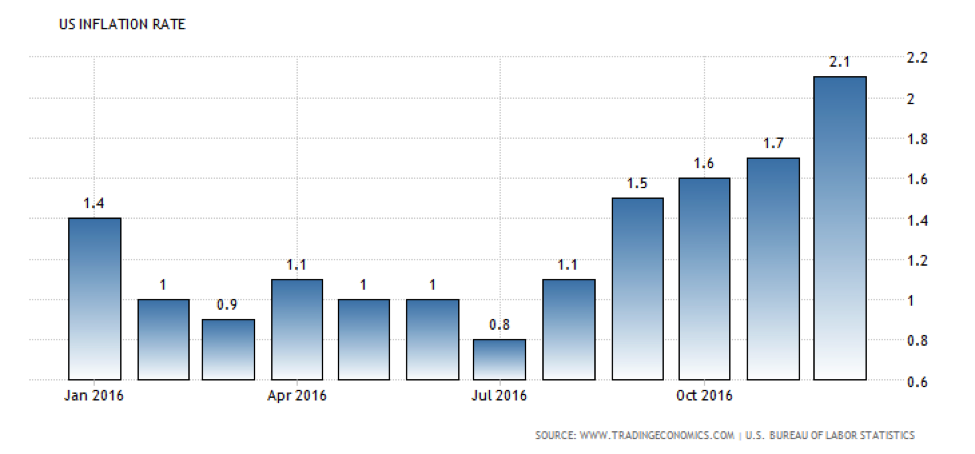After years of low borrowing costs and flat CPI growth, inflation has begun to heat up in recent quarters and many economists believe inflation will gradually rise over the next five years. The New York Federal Reserve forecasts a 2.8% rise in consumer prices in 2017. The inflation rate jumped to 2.1% in December, marking the fifth consecutive month of price hikes. Assuming the Fed’s 2.8% forecast is correct, inflation will exceed the Fed’s target rate of 2% in 2017.

While inflation in food prices is projected to remain modest in 2017, Kiplinger projects continued strong increases in health care costs. According to Kiplinger, health insurance costs will rise by 4% to 6% for employer plans and up to 9% for Obamacare exchange plans in 2017. Another inflation catalyst will be higher housing costs. Home inventories remain tight in many metro markets and rents and home prices are expected to increase by 3.6% in 2017.
The Trump administration’s plan for accelerating economic growth may also contribute to rising inflation. Major components of Trump’s plan include increased infrastructure spending, big tax cuts and renegotiated trade policies, all of which could inflate prices.
For investors wondering if rising inflation will affect the safety and income of mortgage pool funds, here are our thoughts on the impact:
Portfolio Safety
The good news for mortgage pool fund investors is that loans in the fund’s portfolio are secured by real estate. When compared to other assets such as stocks and bonds, real estate has consistently demonstrated superior inflation hedging capabilities. An analysis of the various asset classes by TIAA-CREF indicated that, over the short-term, real estate returns move in tandem with inflation. In addition, over longer periods, real estate returns have consistently outpaced inflation. During the 32-year period of 1978-2010, TIAA-CREF researchers found that the correlation between commercial real estate and inflation averaged 0.41 on an annual basis. Correlation measures the extent to which two assets move together; a 1.00 correlation indicates assets moving in perfect lockstep. A 0.41 correlation suggests a positive relationship between real estate returns and the inflation rate.
Real estate’s correlation with inflation is much higher than inflation’s correlation with stocks, which explains why stocks have historically proven to be a poor short-term hedge against inflation. Bonds were even worse, exhibiting negative correlations that sometimes resulted in negative bond returns when inflation rose. TIAA-CREF cites the example of intermediate-term government bonds, which delivered 4.4% annual returns in the late 1970’s. During this period, inflation averaged 10.1%, meaning that real returns for bond holders were negative 5.7%.
In model portfolios constructed by TIAA-CREF calculating asset returns over a series of five-year holding periods, real estate returns outpaced inflation 83% of the time. On average, real estate returns exceeded the rate of inflation by a healthy 7%.
The characteristics of real estate that make it a relatively effective hedge against inflation are the result of the lease terms and how leases are structured. Short-term leases protect against inflation by allowing rents to be raised frequently and keep pace with CPI growth. Long-term leases typically include built-in rent escalation clauses tied to annual inflation.
In addition, property values keep pace with inflation even when interest rates are rising and borrowing costs move higher. This is due to the fact that, as rents are increased to keep pace with inflation, the income generated by properties also rises. Greater cash flows cause properties to appreciate in value. Escalation in real estate values is most pronounced during periods when property inventories are tight as is the situation now in many metro markets. When demand exceeds supply, property owners gain maximum negotiating power and the ability to impose more favorable lease terms.
Income Generating Capabilities
Inflation’s impact on the cash flows of mortgage pool funds is muted by the short duration of fix-and-flip loans, which give these funds the ability to redeploy assets more frequently and capture the benefits of rising interest rates.
Duration is a measure used by fixed income investors to calculate the sensitivity of an investment to rising interest rates. In general, investments with longer durations tend to have greater sensitivity to rate hikes. A loan’s duration is affected by its maturity, cash flows and yield. Using the example of a bond fund that has a seven-year duration, every 1% increase in interest rates would be expected to reduce the fund’s value by 7%.
When compared to other fixed income investments, mortgage pool funds have very short durations. A typical mortgage pool fund loan matures in only one to three years. In addition, fund yields are at the high end of the fixed income range. Many mortgage pool funds pay 7-10% annual returns to their investors. This is more than triple the 1.9% yield currently available on five-year treasury notes. Short maturities and high yields give mortgage pool funds lower duration numbers and make them less sensitive than other assets to interest rate changes.
In the end, mortgage pool funds will be affected, but real estate can insulate against inflation.
Like any other fixed income investment, mortgage pool funds are affected by inflation. However, when compared to other assets, mortgage pool funds have a built-in advantage due to their real estate exposure. Various studies have shown that holding real estate helps insulate a diversified portfolio against the effects of inflation.
In addition, due to the short duration of their loans, mortgage pool funds are able to redeploy capital more quickly than other investments to capture the benefit of higher interest rates. When rates rise, the proceeds of paid-off loans can be reinvested into higher-yielding assets. Instead of 7-8% returns, rising interest rates may help mortgage pool funds pay 8-9% returns to their investors.
